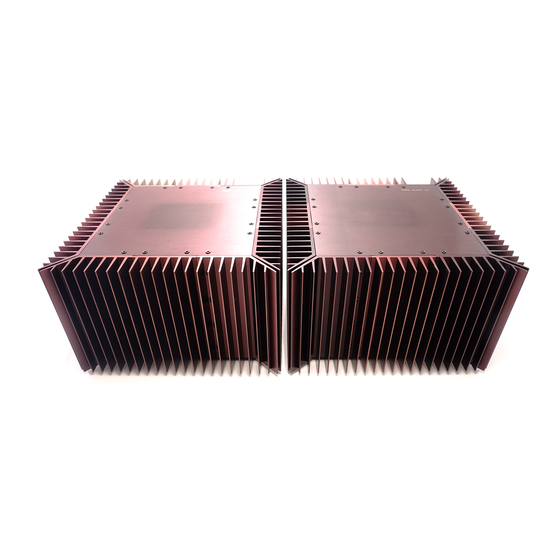
Advertisement
Quick Links
Advertisement

Summary of Contents for Pass Laboratories Aleph 1.2
- Page 1 Pass Laboratories Aleph 1.2 Owner's Manual Serial #...
- Page 2 Most amplifiers on the market have between five and eight gain stages in series between the input and the output. The Aleph 1.2 has but two, and enjoys a very direct path from input to output, further enhancing the purity of the circuit and the resulting sound. Early Aleph amplifiers have three gain stages.
- Page 3 The amplifier has three sets of connections and one switch: The first connection and switch is the AC line power system. The amplifier's voltage and current rating are indicated on the bottom. It will be either 240 volts, 120 volts, or 100 volts, all with a 3AG slow blow type fuse. The frequency rating of the AC line source is 50 to 60 Hz.
- Page 4 When I started designing amplifiers 25 years ago, solid state amplifiers had just achieved a firm grasp on the market. Power and harmonic distortion numbers were king, and the largest audio magazine said that amplifiers with the same specs sounded the same. We have heard Triodes, Pentodes, Bipolar, VFET, Mosfet, TFET valves, IGBT, Hybrids, THD distortion, IM distortion, TIM distortion, phase distortion, quantization, feedback, nested feedback, no feedback, feed forward, Stasis, harmonic time alignment, high slew, Class AB,...
- Page 5 1) Simplicity and a minimum number of components is a key element, and is well reflected in the quality of tube designs. The fewer pieces in series with the signal path, the better. This often true even if adding just one more gain stage will improve the measured specs. 2) The characteristic of gain devices and their specific use is important.
- Page 6 PV 1.4 = 1.26 X 10 4 where P is pressure and V is volume, and whose curve is illustrated in fig. 1. The small nonlinearity which is the result of air's characteristic is not generally judged to be significant at normal sound levels, and is comparable to the distortion numbers of fine amplifiers.
- Page 7 For a 100 watt amplifier, this would be 200 watts out of the wall at idle. As the Aleph 1.2 idles at 2.5 times its rated output, I think we can safely think of it as “pure”.
- Page 8 Designs that vary the bias against the musical signal will generally have bias currents at or below the signal level. This is certainly an improvement from the viewpoint of energy efficiency, but the sound reflects the lesser bias point. I authored the first patent on the dynamically biased Class A amplifier in 1974, however I have not used the technique for the last 15 years.
- Page 9 Mosfets provide the widest bandwidth of solid state power devices, however they were not chosen for this reason. The design of the Aleph 1.2 does not seek to maximize the amplifier bandwidth as such. The capacitances of the Mosfets provide a natural rolloff in conjunction with the resistive impedances found in the circuit, and the simplicity of the circuit allows for what is largely a single pole rolloff characteristic.
- Page 10 Pin 1 of the XLR input connector is ground, pin 2 is the positive input, and pin 3 is the negative input. The Aleph 1.2 is shipped with a shorting plug between pins 1 and 3 of the input XLR connector. This shorting plug sets the gain of the amplifier to 26 dB when you are using the RCA unbalanced input.
-
Page 11: Specifications
500 watts Temperature 25 degrees C. above ambient Dimensions 16.5 " W x 16.5" D x 10.5" H Shipping Weight 120 lb. PASS Pass Laboratories PO Box 219 24449 Foresthill Rd. Foresthill CA 95631 (916) 367 3690 (916) 367 2193...















Need help?
Do you have a question about the Aleph 1.2 and is the answer not in the manual?
Questions and answers